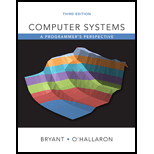
Computer Systems: A Programmer's Perspective (3rd Edition)
3rd Edition
ISBN: 9780134092669
Author: Bryant, Randal E. Bryant, David R. O'Hallaron, David R., Randal E.; O'Hallaron, Bryant/O'hallaron
Publisher: PEARSON
expand_more
expand_more
format_list_bulleted
Question
Chapter 7.5, Problem 7.1PP
Program Plan Intro
Sections in relocatable object files:
There are many sections in a relocatable object file. They are given below:
- “.text”:
- It is the machine code of the compiled program.
- “.rodata”:
- This section is used to read only the data in the format such as
- Strings in “printf” statements.
- Jump tables for switch statements.
- This section is used to read only the data in the format such as
- “.data”:
- This section is used in the initialized “C” variables of global variable and static “C” variables.
- Local “C” variables are initialized at execution time on the stack.
- It does not show in either the “.data” or “.bss” sections.
- “.bss”:
- It is used in the uninitialized global and static “C” variables, along with any global or static variables that are assigned to zero.
- “.symtab”:
- It is a symbol table.
- It contains the information about functions and global variables that are defined and referenced in the program.
- “.rel.text”:
- This section contains a list of locations in the “.text” section.
- It will require to be changed once the linker merges this object file with others.
- This section contains a list of locations in the “.text” section.
- “.rel.data”:
- This section contains relocation information for any global variables that are referenced or defined by the module.
- “.debug”:
- It is a symbol table for debugging
- It contains entries for following
- Definition of Local variables, global variables and typedefs variables and original “C” source file.
- “.line”:
- It is a mapping between line numbers in the given program
- That is in original “C” source program and machine code instructions in the “.text” section.
- It is a mapping between line numbers in the given program
- “.strtab”:
- It is a string table.
- It contains symbol tables in the “.symtab” and “.debug” sections.
- It is the table for section names in the section headers.
- It is a string table.
Expert Solution & Answer
Trending nowThis is a popular solution!

Students have asked these similar questions
Dijkstra's Algorithm (part 1). Consider the network shown below, and Dijkstra’s link-state algorithm. Here, we are interested in computing the least cost path from node E (note: the start node here is E) to all other nodes using Dijkstra's algorithm. Using the algorithm statement used in the textbook and its visual representation, complete the "Step 0" row in the table below showing the link state algorithm’s execution by matching the table entries (i), (ii), (iii), and (iv) with their values. Write down your final [correct] answer, as you‘ll need it for the next question.
4. |z + 5 - 5i| = 7
14.
dz,
C: |z❘
C: |z❘ = 0.6
ze² - 2iz
H
Chapter 7 Solutions
Computer Systems: A Programmer's Perspective (3rd Edition)
Ch. 7.5 - Prob. 7.1PPCh. 7.6 - Practice Problem 7.2 (solution page 718) In this...Ch. 7.6 - Practice Problem 7.3 (solution page 718) Let a and...Ch. 7.7 - Prob. 7.4PPCh. 7.7 - Prob. 7.5PPCh. 7 - This problem concerns the m. o module from Figure...Ch. 7 - Without changing any variable names, modify bar5.c...Ch. 7 - Prob. 7.8HWCh. 7 - Consider the following program, which consists of...Ch. 7 - Let a and b denote object modules or static...
Knowledge Booster
Similar questions
arrow_back_ios
SEE MORE QUESTIONS
arrow_forward_ios
Recommended textbooks for you
 C++ for Engineers and ScientistsComputer ScienceISBN:9781133187844Author:Bronson, Gary J.Publisher:Course Technology Ptr
C++ for Engineers and ScientistsComputer ScienceISBN:9781133187844Author:Bronson, Gary J.Publisher:Course Technology Ptr C++ Programming: From Problem Analysis to Program...Computer ScienceISBN:9781337102087Author:D. S. MalikPublisher:Cengage Learning
C++ Programming: From Problem Analysis to Program...Computer ScienceISBN:9781337102087Author:D. S. MalikPublisher:Cengage Learning Microsoft Visual C#Computer ScienceISBN:9781337102100Author:Joyce, Farrell.Publisher:Cengage Learning,
Microsoft Visual C#Computer ScienceISBN:9781337102100Author:Joyce, Farrell.Publisher:Cengage Learning, EBK JAVA PROGRAMMINGComputer ScienceISBN:9781337671385Author:FARRELLPublisher:CENGAGE LEARNING - CONSIGNMENT
EBK JAVA PROGRAMMINGComputer ScienceISBN:9781337671385Author:FARRELLPublisher:CENGAGE LEARNING - CONSIGNMENT Systems ArchitectureComputer ScienceISBN:9781305080195Author:Stephen D. BurdPublisher:Cengage LearningProgramming Logic & Design ComprehensiveComputer ScienceISBN:9781337669405Author:FARRELLPublisher:Cengage
Systems ArchitectureComputer ScienceISBN:9781305080195Author:Stephen D. BurdPublisher:Cengage LearningProgramming Logic & Design ComprehensiveComputer ScienceISBN:9781337669405Author:FARRELLPublisher:Cengage

C++ for Engineers and Scientists
Computer Science
ISBN:9781133187844
Author:Bronson, Gary J.
Publisher:Course Technology Ptr

C++ Programming: From Problem Analysis to Program...
Computer Science
ISBN:9781337102087
Author:D. S. Malik
Publisher:Cengage Learning

Microsoft Visual C#
Computer Science
ISBN:9781337102100
Author:Joyce, Farrell.
Publisher:Cengage Learning,

EBK JAVA PROGRAMMING
Computer Science
ISBN:9781337671385
Author:FARRELL
Publisher:CENGAGE LEARNING - CONSIGNMENT

Systems Architecture
Computer Science
ISBN:9781305080195
Author:Stephen D. Burd
Publisher:Cengage Learning

Programming Logic & Design Comprehensive
Computer Science
ISBN:9781337669405
Author:FARRELL
Publisher:Cengage